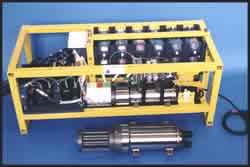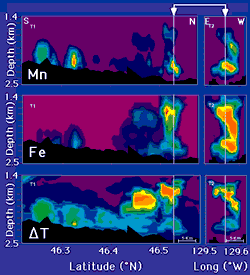| |
 SUAVE,
or a System Used to AssessVented Emissions, provides continuous, in-situ analysis of hydrothermal
chemical species such as iron, manganese and hydrogen sulfide based on
principals of flow analysis and colorimetric detection. In addition to
chemical components, SUAVE is equipped to accept signals from an array
of auxiliary sensors that include state of the art CTD sensors, optical sensors, thermisters, or any other sensor with output
between 0 and 5 vdc. SUAVE is extremely versatile and can be mounted on
a wide variety of platforms for sampling during profiles or transects,
or deployed for short term monitoring applications. SUAVE,
or a System Used to AssessVented Emissions, provides continuous, in-situ analysis of hydrothermal
chemical species such as iron, manganese and hydrogen sulfide based on
principals of flow analysis and colorimetric detection. In addition to
chemical components, SUAVE is equipped to accept signals from an array
of auxiliary sensors that include state of the art CTD sensors, optical sensors, thermisters, or any other sensor with output
between 0 and 5 vdc. SUAVE is extremely versatile and can be mounted on
a wide variety of platforms for sampling during profiles or transects,
or deployed for short term monitoring applications.
 Since
its fabrication in 1991, SUAVE has been deployed on a wide variety of
platforms directed toward hydrothermal research issues. Hydrothermal plumes
have been SUAVE-sectioned vertically, horizontally, and in sawtooth pattern
over almost 1000 km of ridgecrest. The thermochemical attributes of diffuse
venting systems have been determined by SUAVE with spatial detail seldom
achieved anywhere on the seafloor. Relations between macro-fauna and chemical
and thermal distributions at vent habitats have been robustly investigated
using SUAVE. For example, SUAVE has been fitted to CTD, camera, and side-scan
tow packages, to two research submersibles (ALVIN, and SHINKAI 6500) and
3 ROVs (ROPOS, Ventana, and ATV), and demonstrated to be a viable research
tool in each instance. Since
its fabrication in 1991, SUAVE has been deployed on a wide variety of
platforms directed toward hydrothermal research issues. Hydrothermal plumes
have been SUAVE-sectioned vertically, horizontally, and in sawtooth pattern
over almost 1000 km of ridgecrest. The thermochemical attributes of diffuse
venting systems have been determined by SUAVE with spatial detail seldom
achieved anywhere on the seafloor. Relations between macro-fauna and chemical
and thermal distributions at vent habitats have been robustly investigated
using SUAVE. For example, SUAVE has been fitted to CTD, camera, and side-scan
tow packages, to two research submersibles (ALVIN, and SHINKAI 6500) and
3 ROVs (ROPOS, Ventana, and ATV), and demonstrated to be a viable research
tool in each instance.
|
|

